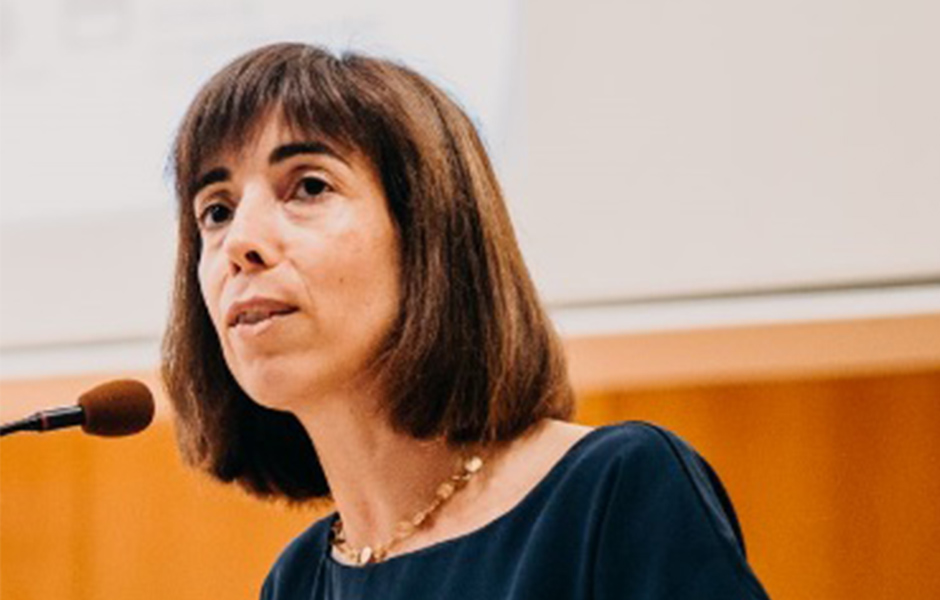Anabela Silva is a researcher of the AgeingC group of CINTESIS at the University of Aveiro (UA) who develops projects and studies mainly in the areas of pain, technologies and elderly people.
She was born in 1978 in Luxembourg, from where she came to Portugal when she was only four years old. She lived and studied in Pombal. She dreamed of becoming a math teacher, a profession that, at the time, was not very popular. “I always liked numbers more than words. I am very happy with a database [laughs]. I’ve always tended toward the more exact sciences,” she says.
She earned a degree in Physiotherapy from the School of Health Technology of Coimbra in 2000, a Master’s degree in Motor Development Biokinetics from the University of Coimbra in 2003, and a Doctorate in Physiotherapy from the Leeds Metropolitan University in the UK in 2009.
“Physiotherapy was not my first choice, nor my second, nor my third. It was a bit of a fluke. In conversation, I was told to choose Physiotherapy because it would be a profession with a future. The truth is that I learned to love physical therapy and working with people. This is a very demanding profession, but it is also extremely rewarding. People trust us”, she refers.
She started working as a physical therapist during her undergraduate studies (after finishing her degree, which, at the time, gave her access to the profession), in a clinic and on a women’s basketball team. In 2001, already at the School of Health of the University of Aveiro (ESSUA-UA), where she helped create the first degree in Physiotherapy, she continued her clinical practice at the Portuguese Cerebral Palsy Association (APPC). In 2002, she became a full-time professor at the UA.
She joined CINTESIS in 2015 due to the need to integrate ESSUA teachers into Research Units. Although she was already doing research since her doctoral studies, this integration brought mainly “institutional support” and “a validation that we need”. “Having the seal of CINTESIS and being able to say that we are researchers of CINTESIS validates what we do, gives another credibility to our scientific profile,” she recognizes.
Currently, the largest project she has in hand is SHAPES – Smart and Healthy Ageing through People Engaging in Supportive Systems, of which she is a Principal Investigator at the University of Aveiro. Besides this, she has several PhD students via CINTESIS, essentially in three areas: pain/chronic pain management; technology; and elderly people.
In the area of pain, the researcher has several ongoing projects related to the study of the effectiveness of pain and exercise neuroscience education, the relationship between chronic pain and cognitive function, and the evaluation of the factors that predispose to the onset of pain and its chronification.
“Access to non-pharmacological treatments is still not for everyone. And when people do have access to them, they are not always the most appropriate ones or the ones that the evidence supports. Interventions like education and exercise are still not in the forefront, due to a number of factors,” she regrets.
Is pain management a luxury? “A little bit,” she replies. “Those in need are still waiting too long for the appropriate intervention, and we know that the longer it takes between the onset of pain and the appropriate treatment, the harder it is to make gains. It is necessary to do, from the start, a proper triage and adjust the intervention to the characteristics of people and their pain, which is still not usual,” she regrets.
In the area of technology, the SHAPES project stands out, which is now “entering” its fourth and last year, with completion scheduled for October 31, 2023. “SHAPES is essentially about adapting technology to people and the role of technology in empowering older people. More than developing new technology, it is about bringing together a set of resources in a service platform, making it easier for the user to access. To this end, it is also necessary to evaluate the technology in a real context of use, identify potential barriers to its use and assess the impact that technology has on functionality, health and well-being of the person,” she explains.
As part of this project, Anabela Silva’s team is conducting a pilot study to evaluate the acceptability and potential impact of using a dance mat and a web interface on the physical and cognitive function of elderly people in the community. In another project, of which she is part, they are developing the contents of an exercise program for older people, which will then be integrated into a web platform.
1-Year Ambition
Next year, I want to successfully complete the SHAPES project and other ongoing projects and try to identify other calls to apply to continue to leverage some of the areas we are working on.
10-Year Ambition
It’s very difficult for me to think 10 years ahead. Although I know what I would like to achieve, I don’t know if it is feasible in that time frame. I would like to aggregate a body of evidence that would allow us to design innovative intervention strategies for people with chronic pain and for elderly people and to evaluate the added value of those interventions. It’s not just about generating knowledge, you also need to transfer that knowledge into clinical practice. You need to bring the evidence to the people who treat patients every day. Being a driving force for innovation in clinical practice is something that I think is important.
Life Beyond Research
I like to spend time with my family. We try to go to the movies, ride our bikes outdoors, do some exercise. I don’t have a special hobby. I like to read a lot, but it’s something I only do on vacation. Since I have a more sedentary lifestyle, I try to make my leisure time more active, favoring physical activity.

